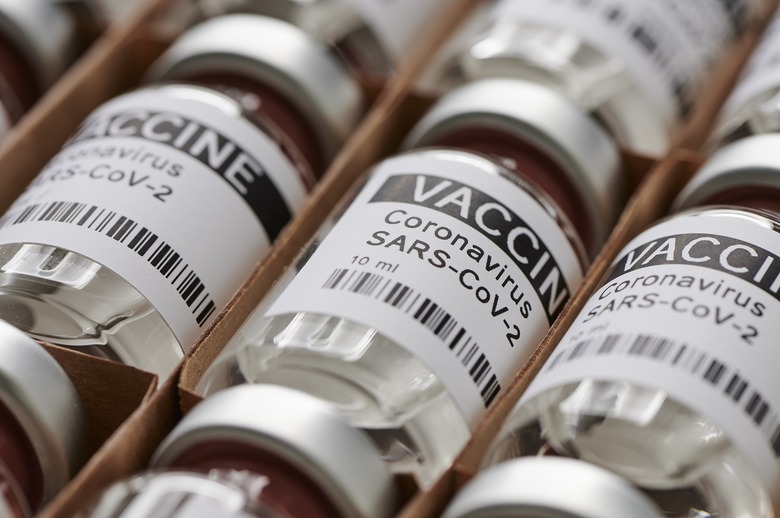This Vaccine Tracker Tells Us When Life Will Return To Normal - You Won't Like The Current Estimate
- Bloomberg compiled all available coronavirus vaccination data into one interactive tracker that can be used to predict how long it will take for countries to reach herd immunity.
- Herd immunity is reached when enough people in the community have developed protection that the coronavirus can no longer spread easily.
- Experts like Dr. Anthony Fauci have said that herd immunity can be reached if 70% to 85% of the population is vaccinated.
- The tracker says the world will need almost seven years to reach herd immunity at the current vaccination rate.
When will the coronavirus pandemic end? How long will it be before the world returns to normal? Health experts and politicians often have to address these questions, especially now that several vaccines have been authorized for emergency use, with at least a couple more set to receive emergency authorization soon. There's no perfect answer to those questions, as several factors can influence the pandemic's path. Vaccines can prevent deaths, and some of them might reduce the risk of transmission, but they can help beat the pandemic only if a larger number of people get immunized. Herd immunity could be reached if anywhere between 70% to 85% of the population is vaccinated, according to comments made by Dr. Anthony Fauci. The expert also said that the US might beat the pandemic by the end of summer 2021, with life returning to some sense of normalcy by the end of the year.
But the vaccine supply simply cannot meet demand right now, and it will take months to get there. The virus continues to mutate, and there's at least one strain that reduces the efficacy of vaccines, a phenomenon that could further complicate the return to normal. A few days ago, we heard a more pessimistic estimate that said it would take 4-5 years for life to revert to normal. Bloomberg gathered the vaccination data available from around the world and created a model to predict the end of the pandemic. The current estimate is even worse than the one above.
The Bloomberg vaccine tracker says that more than 124 million vaccine doses were administered globally so far, which is higher than the number of official COVID-19 cases worldwide. In the US, 38.5 million people were vaccinated at least once, as of Saturday morning, a figure that is also higher than the number of total COVID-19 infections.
The tracker offers interactive maps for the US and the world, showing how many doses were administered in a specific state or country, how many people received at least one dose, and how many people were fully vaccinated. The greener the state or country on the map, the better the vaccination campaign is going.
Israel is the indisputable leader so far, with 37.5% of the population having received one dose of the vaccine and 21.9% being fully vaccinated. At this rate, Israel will be the first country to achieve herd immunity. Israel will reach 75% coverage in just two months, Bloomberg explains. The US will get there "just in time to ring in the 2022 New Year."
![]()
Bloomberg estimated that the will would need almost 7 years to reach 75% immunity at the current rate of vaccination:
Globally, the latest vaccination rate is 4,607,324 doses per day, on average. At this rate, it will take an estimated 6.8 years to cover 75% of the population with a two-dose vaccine.
That's a terrible estimate for various reasons. First of all, if it were to take that long for the entire world to get herd immunity, then many people will continue to die of COVID-19. Moreover, we still have no idea how long protection from vaccinations will last. If immunity wanes after 6-12 months, then booster shots will be required to maintain that herd immunity. This model doesn't factor in that detail.
But Bloomberg acknowledges that the model has limitations. In reality, the model is so deeply flawed that it's almost not even worth paying attention to.
For starters, vaccine manufacturing is still in its early days, and companies are still ramping up production. More stock will be available soon, which will help countries open vaccinations to more groups of people. Additionally, more vaccines will be authorized in the coming weeks. Johnson & Johnson and Novavax have just released Phase 3 trial data. The former has applied for Emergency Use Authorization in the UK. The Oxford drug will also complete the US Phase 3 trial soon.
Also, the J&J candidate is a one-dose vaccine, which could further help countries reach herd immunity. Oxford researchers also concluded that their drug shows better efficacy if the time between doses is longer than 12 weeks — the current recommendation is two doses scheduled four weeks apart.
Finally, the model doesn't include data about natural immunity in the population, which is acquired by people who have already survived COVID-19.
As vaccination rates improve, Bloomberg's interactive tracker will also get better estimates — you can try it at this link.
